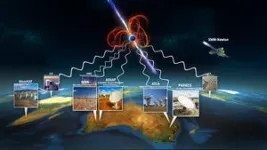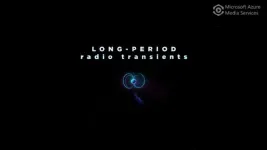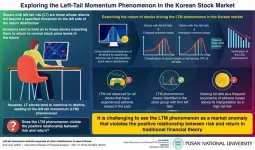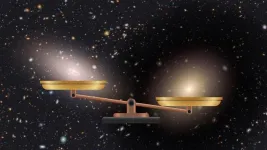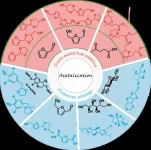(Press-News.org) NASA has awarded funding for three science teams to conduct citizen science investigations as a total solar eclipse sweeps across North America on April 8, 2024. In these experiments, volunteers will help study the Sun and its ethereal outer atmosphere, called the corona, which is revealed when the Moon completely covers the Sun’s bright disk.
“During next year’s total eclipse, hundreds of volunteers will capture images of the Sun and its corona to help answer real science question about our star and how it affects us,” said program scientist and eclipse lead at NASA Headquarters, Kelly Korreck.
“These three projects will build upon citizen scientific efforts from the 2017 solar eclipse and allow a multitude of ways to participate in the eclipse during the Heliophysics Big Year,” said NASA Heliophysics citizen science lead, Elizabeth MacDonald. “Volunteers make this important research possible, and we look forward to seeing what they help reveal.”
The DEB Initiative: Documenting the Corona Moment by Moment
In visible wavelengths of light, the Sun’s surface is much brighter than its corona. During a total solar eclipse, however, observers can see the corona – and scientists can investigate how solar material moves out from the Sun to form the solar wind, an ever-flowing particle stream that impacts Earth and our entire solar system.
The Dynamic Eclipse Broadcast (DEB) Initiative, led by Bob Baer and Matt Penn of Southern Illinois University in Carbondale, will organize volunteers as they capture images of the corona during the 2024 eclipse. Using identical instruments at more than 70 different locations across North America, participants will document the moment-by-moment appearance of the corona throughout the eclipse. Comparing these images across locations, scientists will track plumes of solar material in the difficult-to-study inner corona, estimating their speed and rate of acceleration and linking these observations to those from NASA spacecraft.
The project expands on the team’s efforts during the 2017 total solar eclipse, this time including observation sites outside the path of totality, where part of the solar disk will remain visible. Images from these locations will reveal the source of solar material later observed as outflows in the corona, allowing the team to trace them back to their origins on the Sun.
CATE 2024: Capturing Polarized Views of the Corona
With the help of over 35 volunteer science teams across the U.S., the Citizen Continental-America Telescopic Eclipse (CATE) 2024 experiment aims to study structures and changes in the corona and solar wind. This project, led by Amir Caspi of the Southwest Research Institute in Colorado, will do that by taking images of the corona in polarized light.
Light travels in waves, but those waves can be oriented in different directions, or polarization angles. Similar to how some sunglasses can filter out certain light polarizations, the CATE 2024 cameras will record in four different polarizations. This will help measure the flow of the solar wind, identify signatures of an explosive process thought to generate the solar wind, and understand how structures in the corona are connected.
Each participating team will receive a camera, a telescope, tracking mount, and other supporting equipment. Their images will be compiled into a 60-minute high-contrast movie that scientists will compare with other eclipse observations, including those from NASA space missions. This will help scientists study the processes that shape the heating, structure, and evolution of the corona.
CATE 2024 builds on the Citizen CATE 2017 experiment by using cameras that have a larger field of view and are sensitive to polarization, allowing them to make unique measurements of coronal structures and flows.
Eclipse Megamovie 2024: Recording Dynamics Across the Corona
Total solar eclipses not only reveal the Sun’s corona but can also show the thin layer of the Sun’s atmosphere just below the corona, called the chromosphere. Taking advantage of this unique view, the Eclipse Megamovie 2024 project, led by Laura Peticolas of Sonoma State University in California, will enlist citizen scientists to explore and characterize how superheated gas (plasma) flows through the corona and chromosphere, as well as through the jets, or tendrils of plasma, in those regions.
For this project, at least 100 trained volunteers will take photographs of the total solar eclipse, using cameras on equatorial mounts to compensate for Earth’s rotation. Afterward, the project will provide over 1,200 eclipse photos to scientists and the public. Eclipse Megamovie 2024 will challenge volunteer photographers and data analysts to participate in an image-processing competition to uncover plasma flows and jets in the images.
Eclipse Megamovie 2024 will also compare observations of the eclipse with results from the 2017 Eclipse Megamovie. Peticolas expects that with an increased number of photographs that have different exposure times, the processed images from 2024 will be more visually stunning than those from 2017. Since the Sun is becoming more active – approaching a period known as solar maximum – citizen scientists will also likely capture more activity in the corona and chromosphere than in 2017, providing a wealth of new information.
These projects are funded by NASA’s Heliophysics Citizen Science Investigations (H-CSI) program, which supports citizen science opportunities through medium-scale citizen science projects. As they develop, visit NASA’s eclipse website for more information about how to get involved.
Related Links:
● Science in the Shadows: NASA Selects 5 Experiments for 2024 Total Solar Eclipse
● NASA Heliophysics citizen science projects
● Some citizen science projects during the 2017 total solar eclipse
Media Contact: Denise Hill, NASA Headquarters, Washington
END
NASA funds 3 citizen science projects to study 2024 U.S. solar eclipse
During a total solar eclipse on April 8, 2024, volunteers participating in three NASA-funded projects will help study the Sun and its ethereal outer atmosphere, called the corona, which is revealed when the Moon completely covers the Sun’s bright disk
2023-07-19
ELSE PRESS RELEASES FROM THIS DATE:
Association between markers of structural racism and mass shooting events in major US cities
2023-07-19
About The Study: This study found that major U.S. cities with higher populations of Black individuals are more likely to be affected by mass shooting events, suggesting that structural racism may have a role in their incidence. Public health initiatives aiming to prevent mass shooting events should target factors associated with structural racism to address gun violence.
Authors: Michael Ghio, M.D., of Tulane University in New Orleans, is the corresponding author.
To access the embargoed study: Visit our For The Media website at this link https://media.jamanetwork.com/
(doi:10.1001/jamasurg.2023.2846)
Editor’s ...
Trends, seasonality of emergency department visits, hospitalizations for suicidality among children and adolescents
2023-07-19
About The Study: The findings of this study of 73,000 emergency department visits and hospitalizations for suicidality indicated the presence of seasonal patterns and an observed unexpected decrease in suicidality among children and adolescents after COVID-19–related school closures in March 2020, which suggest a potential association between suicidality and the school calendar.
Authors: Scott D. Lane, Ph.D., of the University of Texas Health Science Center at Houston, is the corresponding author.
To access the embargoed study: Visit ...
Two-faced star exposed
2023-07-19
In a first for white dwarfs, the burnt-out cores of dead stars, astronomers have discovered that at least one member of this cosmic family is two faced. One side of the white dwarf is composed of hydrogen, while the other is made up of helium.
“The surface of the white dwarf completely changes from one side to the other,” says Ilaria Caiazzo, a postdoctoral scholar at Caltech who leads a new study on the findings in the journal Nature. “When I show the observations to people, they are blown away.”
White dwarfs are the scalding remains of stars that were once like our sun. As the ...
Researchers put a new twist on graphite
2023-07-19
FROM: James Urton
University of Washington
206-543-2580
jurton@uw.edu
(Note: researcher contact information at the end)
Embargoed by Nature
For public release at 11 a.m. Eastern Time (8 a.m. Pacific Time; 4 p.m. British Summer Time) on Wednesday, July 19, 2023
Researchers put a new twist on graphite
For decades, scientists have been probing the potential of two-dimensional materials to transform our world. 2D materials are only a single layer of atoms thick. Within them, subatomic particles like electrons can only move in two dimensions. This simple restriction can trigger unusual electron behavior, ...
Understanding the many different ways animals are evolving in response to fire could help conservation efforts
2023-07-19
In our modern era of larger, more destructive, and longer-lasting fires—called the Pyrocene—plants and animals are evolving quickly to survive. By synthesizing the wide body of research about rapid animal evolution in response to fire in a review publishing in Trends in Ecology & Evolution on July 19, a multidisciplinary team of ecology experts hopes to leverage what we already know to help foster evolution-informed conservation plans. In this way, they suggest, we can try to harness the ways in which fire impacts animals to protect vulnerable species—working with evolution instead of against it.
In response to climate change and changes in land use, ...
Astronomers find new type of stellar object
2023-07-19
An international team led by astronomers from the Curtin University node of the International Centre for Radio Astronomy Research (ICRAR) has discovered a new type of stellar object that challenges our understanding of the physics of neutron stars.
The object could be an ultra-long period magnetar, a rare type of star with extremely strong magnetic fields that can produce powerful bursts of energy.
Until recently, all known magnetars released energy at intervals ranging from a few seconds to a few minutes. The newly discovered object emits radio waves every 22 minutes, making it the longest period magnetar ever detected.
The research was published ...
PNU researcher investigates left-tail momentum in the Korean stock market
2023-07-19
Left-tail risk (LT) stocks are those whose returns fall into the extreme end on the left side of the return distribution. In the hopes of mean-reverting to the normal price, investors usually hold on to these stocks. However, contrary to mean-reverting expectations, these stocks that have experienced extreme losses and high tail risks in the past tend to continue declining in the future, resulting in financial losses. This phenomenon, referred to as left-tail momentum (LTM), appears to challenge the traditional notion of a positive relationship between risk and return.
To investigate this market anomaly, a team of researchers, led by Prof. Eom from the School of Business at Pusan National ...
The puzzle of the galaxy with no dark matter
2023-07-19
A team of scientists, led by the researcher at the IAC and the University of La Laguna (ULL) Sebastién Comerón, has found that the galaxy NGC 1277 does not contain dark matter.This is the first time that a massive galaxy (it has a mass several times that of the Milky Way) does not show evidence for this invisible component of the universe. “This result does not fit in with the currently accepted cosmological models, which include dark matter” explains Comerón.
In the current standard model cosmology massive galaxies contain substantial quantities of dark matter, a type of matter which does not interact in the same ...
New catalysts for solar hydrogen production
2023-07-19
Finding sustainable and clean fuels is crucial in today’s global energy and climate crisis. One promising candidate that is increasingly gaining relevance is hydrogen. However, today’s industrial hydrogen production still has a considerable CO2 footprint, especially considering processes like steam reforming or non-sustainable electrolysis.
A team led by Prof. Dominik Eder from the Institute of Materials Chemistry (TU Wien) is therefore focusing on the development of environmentally friendly processes for obtaining hydrogen, for example by photocatalysis. This process enables the conversion of ...
Acetalization: A feasible and sustainable strategy for biomass valorization
2023-07-19
Biomass, mainly composed of lignocellulose and vegetable oil, has been acclaimed as one of the most promising sustainable sources of raw carbon material for the synthesis of transport fuels and value-added chemicals. The catalytic conversion of lignocellulose/vegetable oil and their related derivatives has attracted great attention in biomass valorization. Many elegant methods including hydrolysis, dehydration, hydrogenation, hydrogenolysis, oxidation, etherification, esterification, amination, aldol condensation, ...
LAST 30 PRESS RELEASES:
First Editorial of 2026: Resisting AI slop
Joint ground- and space-based observations reveal Saturn-mass rogue planet
Inheritable genetic variant offers protection against blood cancer risk and progression
Pigs settled Pacific islands alongside early human voyagers
A Coral reef’s daily pulse reshapes microbes in surrounding waters
EAST Tokamak experiments exceed plasma density limit, offering new approach to fusion ignition
Groundbreaking discovery reveals Africa’s oldest cremation pyre and complex ritual practices
First breathing ‘lung-on-chip’ developed using genetically identical cells
How people moved pigs across the Pacific
Interaction of climate change and human activity and its impact on plant diversity in Qinghai-Tibet plateau
From addressing uncertainty to national strategy: an interpretation of Professor Lim Siong Guan’s views
Clinical trials on AI language model use in digestive healthcare
Scientists improve robotic visual–inertial trajectory localization accuracy using cross-modal interaction and selection techniques
Correlation between cancer cachexia and immune-related adverse events in HCC
Human adipose tissue: a new source for functional organoids
Metro lines double as freight highways during off-peak hours, Beijing study shows
Biomedical functions and applications of nanomaterials in tumor diagnosis and treatment: perspectives from ophthalmic oncology
3D imaging unveils how passivation improves perovskite solar cell performance
Enriching framework Al sites in 8-membered rings of Cu-SSZ-39 zeolite to enhance low-temperature ammonia selective catalytic reduction performance
AI-powered RNA drug development: a new frontier in therapeutics
Decoupling the HOR enhancement on PtRu: Dynamically matching interfacial water to reaction coordinates
Sulfur isn’t poisonous when it synergistically acts with phosphine in olefins hydroformylation
URI researchers uncover molecular mechanisms behind speciation in corals
Chitin based carbon aerogel offers a cleaner way to store thermal energy
Tracing hidden sources of nitrate pollution in rapidly changing rural urban landscapes
Viruses on plastic pollution may quietly accelerate the spread of antibiotic resistance
Three UH Rainbow Babies & Children’s faculty elected to prestigious American Pediatric Society
Tunnel resilience models unveiled to aid post-earthquake recovery
Satellite communication systems: the future of 5G/6G connectivity
Space computing power networks: a new frontier for satellite technologies
[Press-News.org] NASA funds 3 citizen science projects to study 2024 U.S. solar eclipseDuring a total solar eclipse on April 8, 2024, volunteers participating in three NASA-funded projects will help study the Sun and its ethereal outer atmosphere, called the corona, which is revealed when the Moon completely covers the Sun’s bright disk


